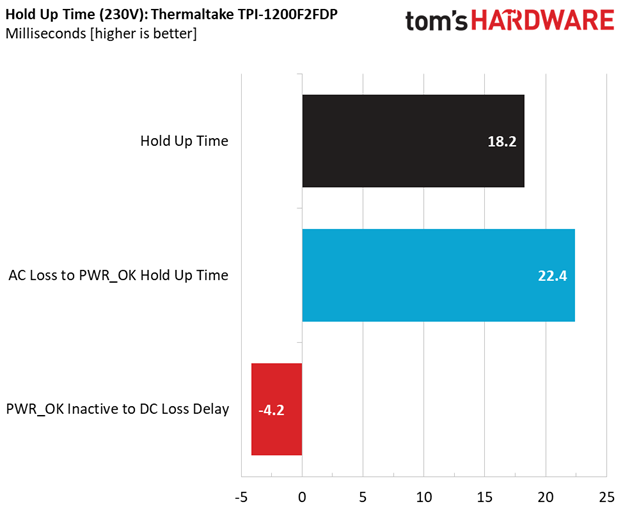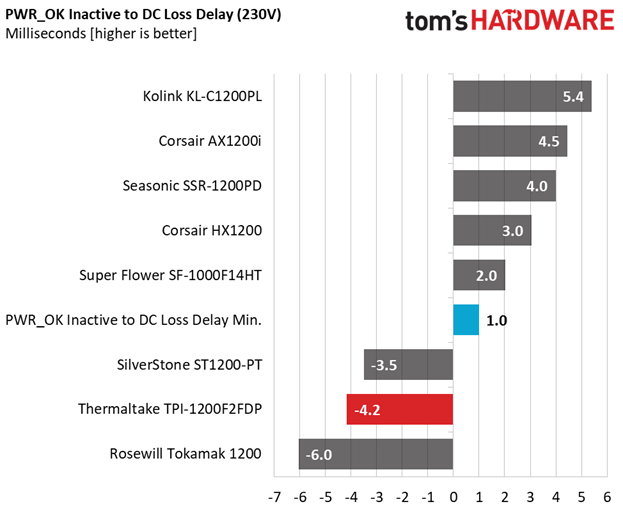Thermaltake Toughpower iRGB Plus 1200W Platinum PSU Review
Why you can trust Tom's Hardware
Load Regulation, Hold-Up Time & Inrush Current
To learn more about our PSU tests and methodology, please check out How We Test Power Supply Units.
Primary Rails And 5VSB Load Regulation
Load Regulation testing is detailed here.








Hold-Up Time
Our hold-up time tests are described in detail here.







A fake power-good signal in a high-end PSU? This is unacceptable! We simply cannot understand why CWT didn't tune its power-good signal properly.
Inrush Current
For details on our inrush current testing, please click here.


The inrush current we measured is pretty low, given this PSU's capacity.
Load Regulation And Efficiency Measurements
The first set of tests reveals the stability of the voltage rails and the TPI-1200F2FDP's efficiency. The applied load equals (approximately) 10 to 110 percent of the PSU's maximum load in increments of 10 percentage points.
Get Tom's Hardware's best news and in-depth reviews, straight to your inbox.
We conducted two additional tests. During the first, we stressed the two minor rails (5V and 3.3V) with a high load, while the load at +12V was only 0.1A. This test reveals whether a PSU is compatible with Intel's C6/C7 sleep states or not. In the second test, we determined the maximum load the +12V rail could handle with minimal load on the minor rails.
| Test # | 12V | 5V | 3.3V | 5VSB | DC/AC (Watts) | Efficiency | Fan Speed | PSU Noise | Temps (In/Out) | PF/AC Volts |
|---|---|---|---|---|---|---|---|---|---|---|
| 1 | 8.172A | 1.975A | 1.985A | 0.991A | 119.795 | 86.464% | 498 RPM | 8.8 dB(A) | 38.41°C | 0.982 |
| 12.020V | 5.057V | 3.319V | 5.038V | 138.549 | 43.96°C | 115.10V | ||||
| 2 | 17.370A | 2.959A | 2.984A | 1.191A | 239.635 | 90.647% | 499 RPM | 8.8 dB(A) | 38.90°C | 0.994 |
| 12.020V | 5.055V | 3.316V | 5.034V | 264.361 | 46.34°C | 115.10V | ||||
| 3 | 26.937A | 3.465A | 3.499A | 1.391A | 359.820 | 91.879% | 500 RPM | 8.8 dB(A) | 39.40°C | 0.996 |
| 12.018V | 5.052V | 3.313V | 5.028V | 391.622 | 49.46°C | 115.10V | ||||
| 4 | 36.488A | 3.962A | 3.983A | 1.591A | 479.627 | 92.119% | 502 RPM | 8.8 dB(A) | 40.09°C | 0.996 |
| 12.016V | 5.050V | 3.311V | 5.023V | 520.658 | 51.45°C | 115.10V | ||||
| 5 | 45.704A | 4.957A | 4.985A | 1.790A | 599.583 | 91.963% | 504 RPM | 8.8 dB(A) | 40.68°C | 0.996 |
| 12.014V | 5.048V | 3.308V | 5.018V | 651.982 | 53.30°C | 115.11V | ||||
| 6 | 54.948A | 5.945A | 5.988A | 1.993A | 719.478 | 91.235% | 653 RPM | 14.6 dB(A) | 41.94°C | 0.997 |
| 12.006V | 5.045V | 3.305V | 5.013V | 788.596 | 60.71°C | 115.12V | ||||
| 7 | 64.214A | 6.945A | 6.989A | 2.195A | 839.348 | 90.301% | 914 RPM | 26.1 dB(A) | 42.96°C | 0.998 |
| 11.995V | 5.043V | 3.303V | 5.008V | 929.502 | 67.15°C | 115.12V | ||||
| 8 | 73.495A | 7.934A | 8.001A | 2.396A | 959.289 | 89.452% | 1165 RPM | 33.9 dB(A) | 44.70°C | 0.998 |
| 11.986V | 5.040V | 3.300V | 5.003V | 1072.409 | 70.01°C | 115.12V | ||||
| 9 | 83.193A | 8.442A | 8.519A | 2.397A | 1079.350 | 88.652% | 1415 RPM | 38.7 dB(A) | 45.58°C | 0.997 |
| 11.981V | 5.038V | 3.298V | 5.001V | 1217.518 | 71.06°C | 115.13V | ||||
| 10 | 92.650A | 8.943A | 9.014A | 3.005A | 1199.190 | 87.552% | 1611 RPM | 42.5 dB(A) | 47.06°C | 0.993 |
| 11.975V | 5.035V | 3.294V | 4.987V | 1369.683 | 75.33°C | 115.11V | ||||
| 11 | 102.722A | 8.946A | 9.020A | 3.005A | 1319.188 | 86.378% | 1827 RPM | 45.5 dB(A) | 48.87°C | 0.987 |
| 11.969V | 5.033V | 3.293V | 4.985V | 1527.224 | 77.63°C | 115.10V | ||||
| CL1 | 0.098A | 16.027A | 16.003A | 0.004A | 135.506 | 82.158% | 519 RPM | 9.4 dB(A) | 45.82°C | 0.975 |
| 12.018V | 5.061V | 3.324V | 5.086V | 164.933 | 64.06°C | 115.14V | ||||
| CL2 | 99.935A | 1.003A | 1.003A | 1.002A | 1210.713 | 87.862% | 1628 RPM | 42.6 dB(A) | 47.40°C | 0.992 |
| 11.981V | 5.039V | 3.298V | 5.020V | 1377.965 | 74.97°C | 115.11V |
Load regulation is very good on all of the rails, although Thermaltake cannot beat the amazing performance levels of Seasonic's Prime Platinum, which is based on a pure analog design. As mentioned, digital platforms might be the future. However, more work must be done before they're able to consistently beat their analog adversaries.
As far as efficiency goes, the TPI-1200F2FDP clears the 80 PLUS Platinum requirement with 20% load, comes close to its target with 50% load, and falls well short of 89% under full load. Obviously, the high temperature we use for testing plays a huge role in the efficiency levels our equipment measures (compare that to 80 PLUS' results, recorded at an unrealistic 23°C, +/-5°C).
Thermaltake's fan profile is fairly conservative. It's only when we push the TPI-1200F2FDP hard that its fan spins up and gets noisy. Up to 70% of its maximum-rated capacity and with an ambient temperature of 43°C, the PSU generates ~26 dB(A) of noise. That's amazing for a 1.2kW PSU. CWT has proven many times that it's able to build high-wattage platforms that don't get loud. The TPI-1200F2FDP is another example of this.
MORE: Best Power Supplies
MORE: How We Test Power Supplies
MORE: All Power Supply Content
Current page: Load Regulation, Hold-Up Time & Inrush Current
Prev Page Teardown & Component Analysis Next Page Efficiency, Temperature & Noise
Aris Mpitziopoulos is a contributing editor at Tom's Hardware, covering PSUs.
-
pjmelect Your videos don't work I get the error "cannot load m3u8 crossdomain access denied (2048)"Reply -
Co BIY Everyone reviews heavily on capacitor quality but how is cap quality determined ? Is it published specs or just reputation / country of origin ?Reply
The bad cap crisis was over ten years ago are all those makers
still putting out bad or inconsistent products ? -
Aris_Mp The videos work fine for me.Reply
Caps: Mostly based on experience and the RMA data that I have access to. The quality of the electrolyte is what matters the most. -
Mike Adams CapXon & Su'scon caps? more chinese junk for a premium price. I would never buy anything from ThermalsewerReply


